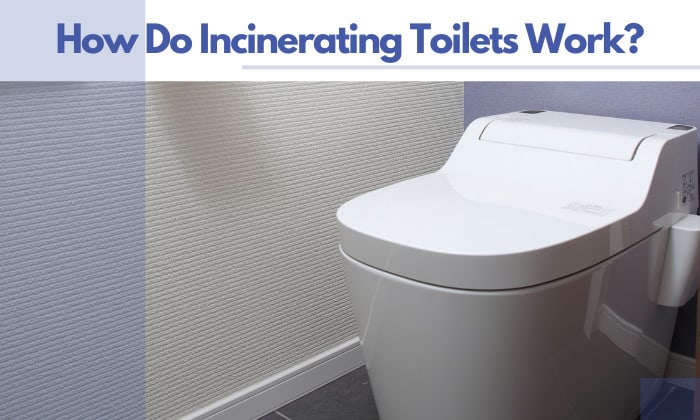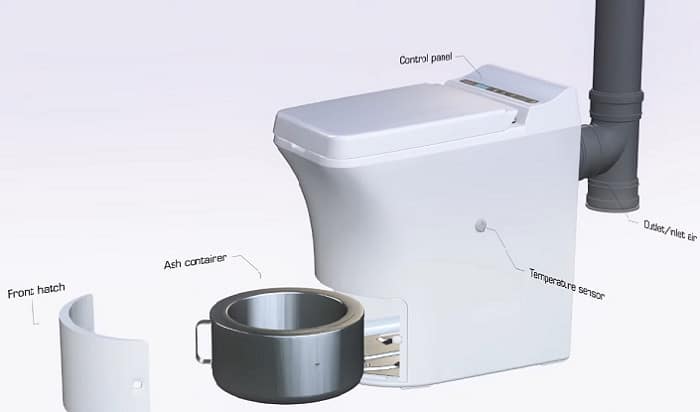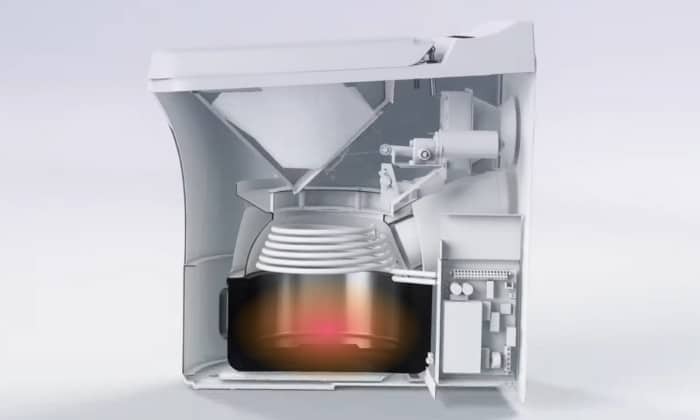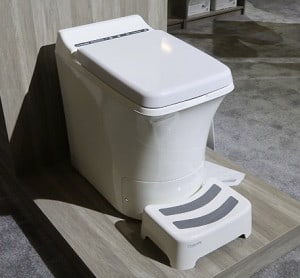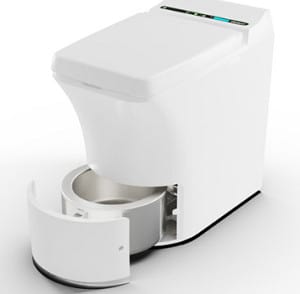While we commonly use water to flush out waste down the drain, did you know that we can also burn it? This is probably a new discovery, so how do incinerating toilets work?
Incinerator toilets work exactly how it sounds: by burning the waste, liquid or solid. They usually need diesel, natural gas, propane, or electricity to power the system and perform incineration.
Table of Contents
Everything About Incinerating Toilets
What is an Incinerating Toilet?
We already mentioned that an incinerating, incinerator, or incineration toilet (they all mean the same thing!) is a toilet that burns waste into ash and vapor using a high temperature that falls typically around 970 – 1400°F (500-750°C). And yes, it doesn’t make use of water.
It was originally made for places that don’t have enough water resources, non-existent sewers, not enough power, and poor waste management. So, if you live in a place like this, getting your own incinerating toilet is the best move.
Claiming a patent over this type of toilet started in the 1940s, but it was in 1958 when a brand called Incinolet became the first to be known for selling incinerating toilets powered by electricity.
To describe them, they look and are shaped like the conventional toilet you would have at home. Except that they have:
- An incineration chamber that has a trap door you can open to take out the sterile ash;
- Filters for managing the bad odor;
- An electric fan;
- A vent pipe where the combustion gasses can exit and;
- In some brand models, the incinerating toilet has a water reservoir for cleaning purposes.
How Do They Function?
Make sure that they are plugged in; even propane toilets need electricity. You might forget this especially if it’s your first time installing an incinerating toilet.
You can utilize the incineration toilet just as you would use a conventional one. However, you have to use a paper toilet liner—that can be cone-shaped or just the ordinary type—for sanitary reasons. This liner is inserted into the bowl.
After urinating or pooping, close the lid and push the incinerating button of the toilet. The incinerating chamber will work and the combustion process will produce harmless gas that will go out of the vent pipe.
You must regularly take the sterile ash out of the toilet. This should be done at least once a week.
Remember, we have to be responsible for what we “flush” because this type of toilet can only incinerate the following:
- urine
- poop
- tampons
- sanitary pads
- toilet paper
- toilet liners
How Can We Clean Them?
The regular cleaning of incinerating toilets is pretty simple, especially if you use toilet liners.
- For the ash container, take it out of the chamber and empty it. Pour hot water and wait for 15 to 30 minutes before brushing the ash residue using the cleaning brush. Rinse after.
- For the bowl itself, make sure to unplug the toilet first. Wipe the toilet, seat, and lid with a damp cloth, or you may use cleaners such as 409 which the brand Incinolet recommends for its products.
In the annual cleaning, we ensure that the vent and exhaust pipe are free of dust. The Cinderella brand has provided simple ways to do this.
- For the exhaust pipe, remove the ash container first. Brush the pipe with a bottle brush and place the nozzle of the vacuum cleaner in the hole to absorb the loose particles.
- For the catalyst, we need to do a flush. Remove the ash container and put the toilet outdoors or in a tub, then tilt the toilet forward at 20 centimeters (cm) above the ground.
Fit a funnel into the exhaust pipe because it is where the warm water will run through, and we will pour it until it comes out clear.
- For the pipes, we can use a sweeper set with a weighted ball.
What Are the Kinds of Incinerating Toilets?
1. Electric Incinerating Toilet
This type consumes 1.5 to 2 kilowatt-hours (kWh) for each burning cycle. We can also refer to this as the solar incinerator toilet since it can be powered using solar panels.
Although, we should keep in mind that not all electricity or solar-powered toilets are made to incinerate.
2. Propane, Diesel, or Gas Incinerating Toilet
A propane incinerator toilet can get 75 to 100 burn cycles using an 11-kilogram (kg) or 20-pound (lb) propane bottle.
This type of incinerating toilet still needs electricity to power the electric fan, gears, and burner.
Pros and Cons of Incinerating Toilets
Advantages
- Incinerating toilets are powered by electricity or gas, which means we can conserve water compared with using gallons of it in conventional toilets for flushing.
- Easy installation because it doesn’t have to connect to the sewers; that’s why incinerating RV toilets are common.
- Portability as well, that’s why they are compatible with RVs.
- Consume little space.
- Easy to clean and maintain.
Disadvantages
- Incinerating toilets cost a lot, falling between $1,200 and $5,000.
- You would have to buy paper toilet liners whose price will depend on the brand.
- Your electricity prices will go higher since incinerating toilets can cost $0.22 to $0.30 for each “flush.”
- The incineration process burns the nutrients you can use for fertilizers.
Frequently Asked Questions
What Happens to Pee in Incinerating Toilets?
Since incinerating toilets use high temperatures of 500-750°C, the urine evaporates into a gas and is released out of the vent.
How Long Does the Incineration of Waste Last?
The incinerating toilet will take one to three hours to burn all the waste, depending on the amount completely.
How Long Does an Incinerating Toilet Last?
With proper care and maintenance, incinerating toilets can last approximately 20 years. Different brands have their own maintenance service intervals to make sure that we can maximize the lifespan.
How Much Does It Cost to Incinerate a Toilet?
Electricity costs for toilet incineration can be between $0.22 to $0.30.
In the propane-fueled incinerating toilets, a gallon of propane will cost $2 to $4 or more. If you need 700 to 100 burn cycles, you must have 3.89 gallons (20 lbs) of propane.
Can You Make A DIY Incinerator Toilet?
Unfortunately, there hasn’t been any attempt or success in creating a DIY incinerator toilet. A product like this is too technical and requires years of planning and testing before it can be put on the market to be used by consumers.
Related article: Incinerating toilet vs composting toilet
Conclusion
So, how do incinerating toilets work? Incinerating toilets work by burning mainly human waste, along with toilet liners, toilet papers, sanitary pads, and tampons at a high temperature. They can be operated by electricity or gas, propane, and diesel. With the latter, we still need electricity for the fan, gears, and burners.
One of the notable advantages of this kind of toilet is they do not use water. We also don’t need a big space and a complicated installation. With a lifespan of 20 years or more, this toilet brings comfort, benefits, and help to the environment.

I’m Paulk Webb, and I work as a writer for Saveourwaterrebates. I’m happy to put in the time and effort to conduct market research to identify the most pressing issues faced by households concerning their plumbing. Feel free to check out our guides to get the most informed recommendations for how to solve your problems.


